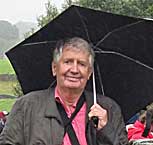 One should not start a project that one cannot complete. Having started writing a blog on the first day of my pilgrimage to Hadrian’s Wall I must confess that I failed to keep it up. It was not for lack of trying. Every night in my room I wrote up my diary, often over 2000 words long. I dictated it into my computer. I have a splendid new programme called Dragon Naturally Speaking which puts my words onto the screen, but it has its idiosyncrasies. It would call Hadrian’s Wall Hadrian’s War but I am gradually sorting out the results and I hope they will form the basis of a Hadrian’s Wall issue of Current Archaeology.
One should not start a project that one cannot complete. Having started writing a blog on the first day of my pilgrimage to Hadrian’s Wall I must confess that I failed to keep it up. It was not for lack of trying. Every night in my room I wrote up my diary, often over 2000 words long. I dictated it into my computer. I have a splendid new programme called Dragon Naturally Speaking which puts my words onto the screen, but it has its idiosyncrasies. It would call Hadrian’s Wall Hadrian’s War but I am gradually sorting out the results and I hope they will form the basis of a Hadrian’s Wall issue of Current Archaeology.
It must be said, the weather was not kind. The weather forecast consistently said ‘changeable’ and in this it was correct; and although my friends up there said, no, it was not rain it was just drizzle, I must say that we rarely saw the sun. Nevertheless I took over 1600 photographs – if I ever have time to look at them.
I went in fact on two separate conferences: first, there was the Pilgrimage organised jointly by the two northern societies, the Society of Antiquaries of Newcastle upon Tyne and the Cumberland and Westmoreland Antiquarian and Archaeological Society. As Pilgrims we concentrated naturally on Hadrian’s Wall itself. The second week was then given over to the 21st International Limes (Roman Frontiers) Congress held at Newcastle. This had people coming from all the frontiers of the Roman Empire, with people from Germany, Holland, Austria and Serbia as well as from Bulgaria where it is hoped that the next congress will be held in three year’s time. This inevitably concentrated on the other frontiers of the Roman Empire, but we alternated between days of lectures and days of excursions.
So what are my favourite impressions? It must be said that the most interesting sites I saw were actually off the Wall itself. This was partly deliberate. The central parts of Hadrian’s Wall are over-visited and so deliberate effort is being made to attract people to the off-Wall forts and I will be expiating about them in Current Archaeology. The most impressive of all was Hardknott Castle which I must confess I had never visited. It is in the middle of the Lake District and is difficult to get to by car. We went over to Ambleside by coach and we then transferred to mini buses called Mountain Goats which took us through the pouring rain to Hardknott. Here fortunately the rain ceased and there were even a few gleams of sunlight but the fort was sopping wet and my trainers were soon soaked through; but it is an amazing fort and even more amazing is the parade ground adjacent. Just to think of the Romans constructing this huge parade ground high up in the mountains!
And then we went to a fort I had never even heard of, Whitley Castle in the North Pennines, about a dozen miles south of Haltwhistle. This is said to have been placed by the Romans for the control of the lead mines, but it is amazingly well preserved, and deserves to be better known. But in a way one hopes that it will not be better known, – perhaps we should keep it as a secret in its pristine unmolested state!
Inevitably too one came up against the politics of the wall. A new quango has been set up called Hadrian’s Wall Heritage Ltd which has just produced a grandiose Management Plan for the wall from 2008 — 2014 and I shall be having some animadversions about it. But don’t worry, I shall be absolutely fair and explain to you all precisely what they are doing.
I have ambitious ideas of doing a special issue on Hadrian’s Wall, boiling down the best bits of my diary and making a choice selection of my 1600 photographs. We might even do a web site to accompany it, so watch this space, or rather watch the forthcoming issues of Current Archaeology when I hope to be able to reveal the true inside story of what is happening along Hadrian’s Wall.
P.S. Did I mention that there is also the Roman Frontiers Congress as well? I met lots of fascinating people from the other parts of the Roman frontiers and I have all sorts of interesting places to visit – Vienna and Carnuntum , Belgrade and Viminacium and a fascinating Roman palace hidden deep in the Serbian vastness. All should be visited, and all should provide fascinating articles for Current World Archaeology.



